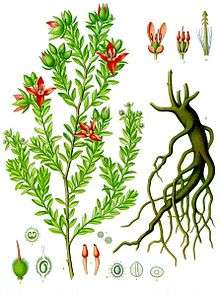Krameria
Krameria is the only genus in the Krameriaceae family, of which any of the approximately 18 species[3] are commonly known as rhatany, ratany or rattany. Rhatany is also the name given to krameria root, a botanical remedy consisting of the dried root of para rhatany (Krameria argentea) or Peruvian rhatany (Krameria lappacea).
| Krameria | |
|---|---|
 | |
| K. lappacea | |
| Scientific classification | |
| Kingdom: | Plantae |
| Clade: | Tracheophytes |
| Clade: | Angiosperms |
| Clade: | Eudicots |
| Clade: | Rosids |
| Order: | Zygophyllales |
| Family: | Krameriaceae Dumort.[1] |
| Genus: | Krameria L.[2] |
| Species | |
|
17–18 – see text | |
The biological action of rhatany is caused by the astringent rhataniatannic acid, which is similar to tannic acid.[4] Infusions have been used as a gargle, a lozenge, especially when mixed with cocaine,[4] as a local hemostatic[4] and remedy for diarrhea. When finely powdered, the dried roots furnished a frequent constituent of tooth powders. The powdered roots have also served, especially in Portugal, to color wines ruby red. The root bark contains an almost insoluble free red substance called ratanhia red.
Krameria are found across the Americas, with most native to the tropical regions. They are perennial shrubs which act as root parasites on other plants. The flowers have glands called elaiophores which produce a lipid which is collected by bees of the genus Centris as they pollinate the flowers.
Selected species
- Krameria argentea Mart. ex Spreng. – para rhatany
- Krameria bicolor S.Watson (=K. grayi) – white rhatany
- Krameria cistoidea
- Krameria erecta Willd. ex Schult. & Schult. f. – Pima rhatany, purple heather, littleleaf rhatany
- Krameria ixine L. – abrojo Colorado
- Krameria lanceolata Torr. – trailing krameria
- Krameria lappacea (Dombey) Burdet & B.B.Simpson (=K. triandra, K. iluca) – Peruvian rhatany
- Krameria ramosissima (A.Gray) S.Watson – manystem rhatany[5][6]
References
- Angiosperm Phylogeny Group (2009). "An update of the Angiosperm Phylogeny Group classification for the orders and families of flowering plants: APG III" (PDF). Botanical Journal of the Linnean Society. 161 (2): 105–121. doi:10.1111/j.1095-8339.2009.00996.x. Retrieved 2013-07-06.
- "Genus: Krameria L." Germplasm Resources Information Network. United States Department of Agriculture. 2005-01-31. Archived from the original on 2012-10-10. Retrieved 2011-01-28.
- Christenhusz, M. J. M.; Byng, J. W. (2016). "The number of known plants species in the world and its annual increase". Phytotaxa. 261 (3): 201–217. doi:10.11646/phytotaxa.261.3.1.
- Chisholm, Hugh, ed. (1911). . Encyclopædia Britannica. 7 (11th ed.). Cambridge University Press. p. 231.
- "Krameria". Integrated Taxonomic Information System. Retrieved 2011-01-28.
- "GRIN Species Records of Krameria". Germplasm Resources Information Network. United States Department of Agriculture. Archived from the original on 2015-09-24. Retrieved 2011-01-28.
- Simpson, B. B. (1982). Krameria (Krameriaceae) flowers: Orientation and elaiophore morphology. Taxon 31:3 517–528
- Rines, George Edwin, ed. (1920). . Encyclopedia Americana.
External links
| Wikimedia Commons has media related to Krameria. |
| Wikispecies has information related to Krameria |